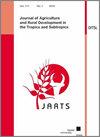Smallholder goat production in the Namaacha and Moamba districts of southern Mozambique
Q3 Social Sciences
Journal of Agriculture and Rural Development in the Tropics and Subtropics
Pub Date : 2018-12-17
DOI:10.17170/KOBRA-2018112825
引用次数: 8
Abstract
Goat rearing is one of the most common livestock farming activities in Mozambique and has the potential to play a powerful role in improving the livelihoods of resource-poor farmers. This study was conducted to investigate the status of goat husbandry practices in rural areas of southern Mozambique. Data were collected from a total of 45 smallholder goat keepers in three different villages through questionnaires complemented by interviews. Most households were dependent on crop production and livestock as their main source of income. Goats were reared under extensive systems where free grazing and tethering were the common feeding management practices with limited supplementation during the dry season. The flock sizes per household were predominantly small (13 ± 2.4) with uncontrolled breeding of goats. The goats were reared mainly as a source of meat for home consumption and a means of reserve cash income. All household members were involved in goat production but women and children had a minor role in terms of decision making. The main constrains limiting goat production were diseases, lack of veterinary services, limited size of grazing land and scarcity of feed resources. Intervention programs focused on improving the husbandry practices and veterinary assistance should be initiated to improve goat production and thereby improve the income and livelihood of the resource-poor farmers in Mozambique. This paper presents a summary of the results of a baseline study in the Namaacha and Moamba districts of Mozambique.莫桑比克南部Namaacha和Moamba地区的小型山羊生产
山羊饲养是莫桑比克最常见的畜牧业活动之一,有可能在改善资源匮乏农民的生计方面发挥强大作用。本研究旨在调查莫桑比克南部农村地区山羊饲养实践的现状。通过问卷调查和访谈,从三个不同村庄的45名小农户山羊饲养者那里收集了数据。大多数家庭依靠作物生产和牲畜作为主要收入来源。山羊是在广泛的系统下饲养的,在旱季,自由放牧和系留是常见的饲养管理做法,补充量有限。每个家庭的羊群规模主要较小(13 ± 2.4)山羊不受控制的繁殖。山羊的饲养主要是作为家庭消费的肉类来源和储备现金收入的一种手段。所有家庭成员都参与了山羊生产,但妇女和儿童在决策方面的作用很小。限制山羊生产的主要制约因素是疾病、缺乏兽医服务、牧场面积有限和饲料资源稀缺。应启动以改善畜牧业做法和兽医援助为重点的干预计划,以提高山羊产量,从而改善莫桑比克资源匮乏农民的收入和生计。本文总结了莫桑比克纳马查和莫安巴地区的基线研究结果。
本文章由计算机程序翻译,如有差异,请以英文原文为准。
求助全文
约1分钟内获得全文
求助全文
来源期刊
CiteScore
2.30
自引率
0.00%
发文量
0
审稿时长
>36 weeks
期刊介绍:
The Journal of Agriculture and Rural Development in the Tropics and Subtropics publishes papers dealing with original research and review papers in the fields of plant production, animal nutrition and animal husbandry, soil science, rural economy and farm management, forestry and forest economy, veterinary hygiene and protection against epidemics.

 求助内容:
求助内容: 应助结果提醒方式:
应助结果提醒方式:


